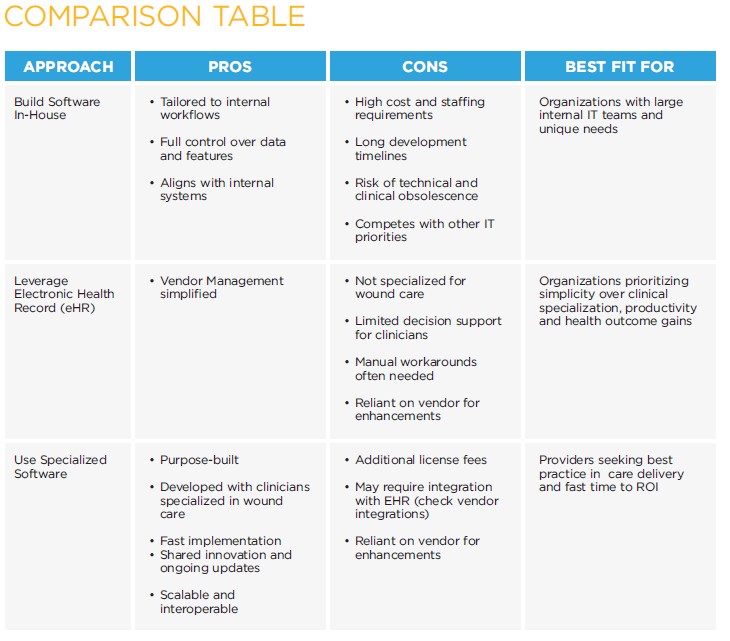Build VS. Buy A strategic perspective on digital wound management.
September 12, 2025
ADVANCING DIGITAL HEALTHCARE
Home and community care providers face mounting pressure from increased patient acuity, complex wound care demands, and the need for measurable outcomes. Organizations must choose between three paths: build internal software, rely on existing electronic health record (EHR) systems, or license specialized digital wound management software. Leading analyst firms reinforce the strategic preference for buying, especially in specialized clinical domains where innovation, best practices, and measurable outcomes are required.
👉 Receive a download link to our free case study from below by filling out the form on the right (it will be emailed to you) and contact us to schedule a demo.
The following table provides a summary of optional approaches.

ANALYST INSIGHTS: WHAT THE RESEARCH SAYS
- McKinsey notes that on average, large IT projects run 45 percent over budget and 7 percent over time while delivering 56 percent less value than predicted. Software projects run the highest risk of cost and schedule overruns [1].
- Forrester confirms that buying software reduces both capital and staffing costs over time. Ongoing maintenance for in-house builds can consume up to 25% of capital annually [2].
- Gartner’s ‘Buy, Build or Blend’ framework encourages organizations to buy for common needs and build only for strategic differentiators [3].
VENDOR SPECIALIZATION: AND CLINICAL INNOVATION
- Analyst firms highlight that mature clinical domains like wound care are ideal candidates for purchasing proven solutions
- Purpose-built wound care platforms have proven ROI, evolve rapidly based on frontline clinical feedback, delivering best practices system-wide [4].
- A study across fourteen home-health branches found that adopting an AIpowered wound-specific solution led to a 4.3-day faster healing per wound and operational efficiencies (fewer nursing visits, shorter visit duration), compared to control zones relying on general home health records [5].
STRATEGIC ADVANTAGES: OF DIGITAL WOUND MANAGEMENT SOFTWARE PLATFORMS
Specialization Focus: Built solely for wound care, ensuring alignment with clinical workflows.
Continuous Improvement at Scale: Platforms evolve from input by thousands of users.
Faster Results with Less Risk: Quick deployment and vendor support reduce internal IT burden.
Predictable Costs and Scalability: Licensing models eliminate hidden long-term costs.
CONCLUSION
For home and community care providers, licensing a specialized digital wound management platform offers clear strategic, financial, clinical and operational advantages. Analysts consistently advise that buying mature, clinically validated systems results in faster value, lower total cost, and reduced risk.
FOOTNOTES
[1] https://www.mckinsey.com/~/media/McKinsey/dotcom/client_service/Corporate%20Finance/MoF/PDF%20iss
ues/PDFs%20Issue%2045/Final/MoF45_LargeScaleIT.ashx
[2] https://www.forrester.com/blogs/new-research-reframing-the-buy-vs-build-choice/
[3] https://verato.com/blog/gartner-model-for-smarter-tech-decisions-in-financial-services/
[4] https://bmchealthservres.biomedcentral.com/articles/10.1186/s12913-025-12969-2
[5] https://nursing.jmir.org/2025/1/e71535?utm
